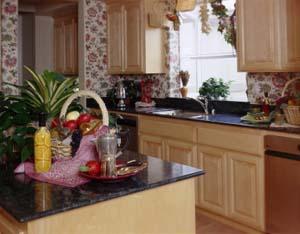
Learning how to paint kitchen countertops can provide you with the tools necessary for making your old, outdated kitchen fresh and inviting without a major renovation. With only a few paint supplies, you can transform your laminate kitchen countertops from drab to fab.
Color Selection
One of the greatest advantages to painting your kitchen countertops is your choice of color. Paint stores and home improvement super-centers have thousands of color selections for paint. You can even mix and match colors or use various techniques to give your countertops the look of real stone or marble.
The problem with this level of flexibility is making a final decision. Figure out what you want your finished project to look like before you head to pick out the paint color to help keep your color palette selection under control.
Prepping and Priming Your Kitchen Countertop
Before you start painting the kitchen countertop, clean it thoroughly with warm soapy water and rinse with fresh, clean water to avoid getting any dirt back on the surface. Remove all cooking oils and grease from the surface or the paint will have difficulty adhering to the countertop.
Use fine to medium grit sandpaper to sand the surface of the countertop and vacuum up all of the dust once completed. The sandpaper will remove the shiny coating from the laminate providing a more porous surface for the primer to stick to.
Apply tape to the walls or backsplash along where it meets the countertop as well as the edges of the sink and any recessed cutting boards. This will help prevent paint from getting on areas outside of the paint zone.
Apply a coat of primer to your kitchen countertop and wait for it to fully dry before applying additional paint. To help your paint job go smoother and faster, have the person behind the paint counter tint your primer the same color as your primary color of paint. This will help reduce the number of coats you'll have to apply and allow the paint to cover the area more thoroughly.
Painting a Kitchen Countertop
The process of learning how to paint kitchen countertops is very similar to painting a wall. Cut in the countertop first by applying paint to the corners and along the edges with a brush. This allows you more controlled in your application and helps prevent accidental over-painting.
Once the countertop is cut in, apply paint to the rest of the surface. In most cases, if you used colored primer, one coat of paint will do but wait for it to dry to determine if a second coat is required.
Allow the paint to fully cure for two days and apply a coat of clear urethane. After the urethane has dried, lightly sand the surface and apply another coat of clear urethane. Continue this process until you have the sheen you desire. If you're getting brush strokes noticeable in your urethane applications, thin the solution very slightly with water to help it go on easier.
Special Considerations for Painted Countertops
Taking the time to learn how to paint kitchen countertops properly can result in a beautifully finished kitchen, but your job of maintaining your countertop is just beginning. It's important to remember that although your countertop has a durable clear coat of urethane, it is not heat resistant and it can be easily marred by metal objects. Here are a few tips for maintaining the look of your newly painted kitchen countertop.
- Use a cutting board every time you use a knife to cut or slice something.
- Avoid sliding metal cans or other metal objects across the surface of the countertop.
- Do not place hot objects directly on the surface of the countertop to avoid melting urethane finish.
- Clean the countertops thoroughly
- Lightly sand the surface and apply a fresh coat of urethane every six months .







